-
Photo and Video File Recovery Tutorial 2025
You may read about how to recover files on other cases:
Get Deleted Files Back
HD Video Recovery from SD cards
Recovery from an External Device with a Damaged File System
In the modern digital world, almost everyone has a huge collection of photo and video files. These files are large, especially video ones, which may reach dozens of GBs. Storing such vast data volumes may be hard even for modern high-capacity storage devices, and quite often some photo and video files must be deleted to free the storage space for new ones. Humans make mistakes and quite often they delete files they wish they hadn’t. Such a situation seems catastrophic, but fortunately there are ways to recover such mistakenly deleted files.
R-Photo is a program that helps in such a situation. What is important, is it does it for free despite the fact that it has the same data recovery engine as the professional R-Studio data recovery software.
This article will show you how to recover such deleted photo and video files.
Some preliminary information
Files can be deleted in Windows in three ways: they can be moved to Recycle Bin (a standard Windows "Delete" procedure), they can be deleted without Recycle Bin (Shift+Del keys on the keyboard), and they can be moved to Recycle Bin and then Recycle Bin can be emptied. We'll discuss all these three cases in this article.
An important note: it may seem that files from Recycle Bin can be restored using a standard Windows "Restore" procedure, but this not always works this way. Quite often when an external disk is connected to another Windows machine the information on files in Recycle Bin gets lost, and that procedure doesn't work anymore.
To demonstrate photo and video file recovery, we prepared an external hard disk with digital movies and files from a digital photo camera. Then we moved some photo files to Recycle Bin and emptied it, then moved some other photo and video files to Recycle Bin and deleted some without it. So, the disk contains all three types of deleted files.
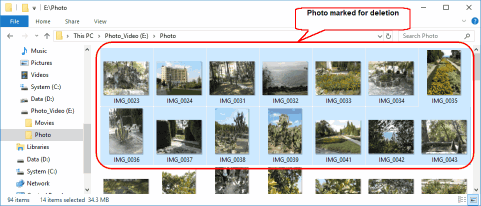
Click image to enlarge
Photo and Video Files Recovery: Deleted photo files
Note that Windows deletes large files immediately without Recycle Bin even if you use a standard Windows Delete procedure to move them to Recycle Bin.
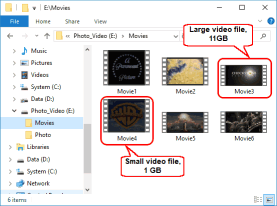
Click image to enlarge
Photo and Video Files Recovery: Deleted video files
Before You Begin
First, it's important to minimize the amount of new data that your computer writes (saves) to the hard drive the deleted files were located. Stop actively using the computer or external hard drive where the deleted files were located. If you are downloading something onto the system disk, stop the download. Don't launch any programs, don't create and/or save any non-essential files, and restrict Internet browsing until the files have been successfully recovered. Don't even turn off or reboot your computer or disconnect the external hard drive from the computer; Windows writes heavily to the computer disks during the startup and shutdown processes.
There is no guarantee that your deleted files won't be overwritten, however following the above guidelines significantly reduces your chances that this will happen.
Leave your computer running but avoid using it. If you have access to another computer, use it for the next few steps. Download R-Photo on a secondary machine and copy it to an external storage device, such as a USB drive or a CD-RW.
Installing R-Photo
Download, install, and run R-Photo. If you're going to recover files from a system disk, install R-Photo on an external removable device to avoid overwriting the deleted files. See the R-Photo install/uninstall web page for more information.
Recovering Deleted Photo and Video Files with R-Photo
Choose the disk where your deleted photo and video files were located. In our example, we'll be selecting the external hard drive E:\.
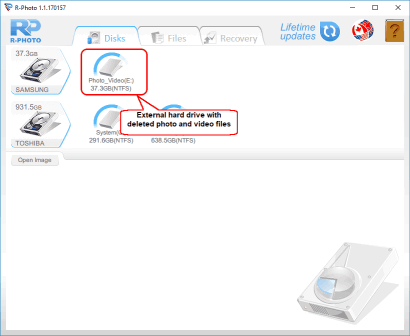
Click image to enlarge
R-Photo: Disks panel
Move the cursor over the disk and click Show files.
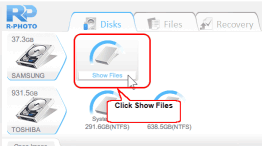
Click image to enlarge
R-Photo: Show files
R-Photo will start searching for photo and video files on the disk. This may take a while, depending on how large your hard drive is.
When R-Photo has found all photo and video files on the disk, it is necessary to find the files you want to recover. R-Photo sorts photo and video files by their types and places them to the Pictures and Videos tabs respectively. We'll start with the first tab Pictures. This tab displays photo files in tiles by default. That makes finding the required deleted files much easier.
All three types of deleted files are displayed slightly differently. When Windows moves files to Recycle Bin, it changes their names to some random character combinations always started with the $ character.
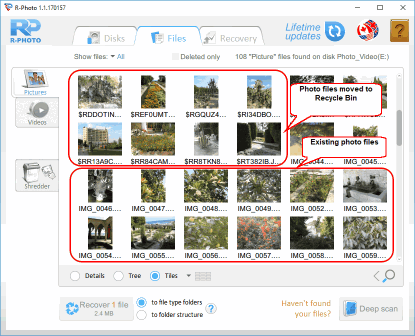
Click image to enlarge
Photo files moved to Recycle Bin
Files deleted without Recycle Bin keep their names but have a special red cross mark indicating that those files have been deleted.
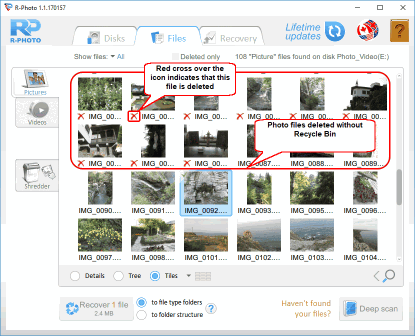
Click image to enlarge
Photo files deleted without Recycle Bin
Files from emptied Recycle Bin have both random character names and the red cross.
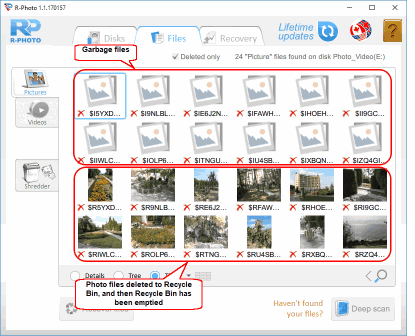
Click image to enlarge
Photo files from emptied Recycle Bin
There are always some severely damaged or garbage files you wouldn't want to recover. They don't have any kind of images on their tiles.
You can also find files by searching for them manually. Refer to the R-Photo: File Search and File Sorting online help pages.
If you cannot find all deleted files, you may use Deep scan to make R-Photo search for them thoroughly. Refer to the Deep Scan help page for more details.
You may use the built-in viewer to estimate chances for successful file recovery, or to find a necessary file to recover. Right-click the file to view it.
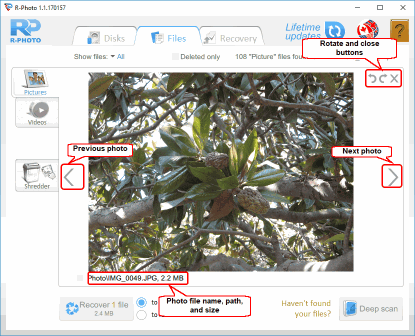
Click image to enlarge
File Viewer: Photo files
When all your deleted photo files are found, mark them for recovery by clicking them:
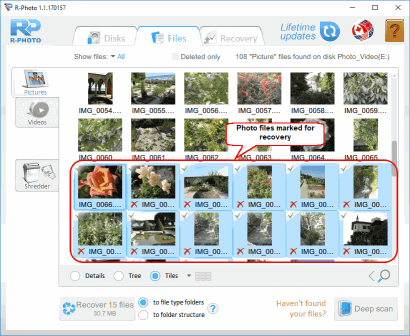
Click image to enlarge
Files marked for recovery
When all necessary photo files are found and marked, you may go to the Video tab to search for deleted video files. R-Photo will show them differently:
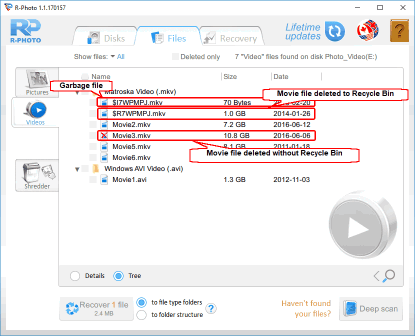
Click image to enlarge
Deleted video files
You may also view video files. R-Photo will show them in a separate window.
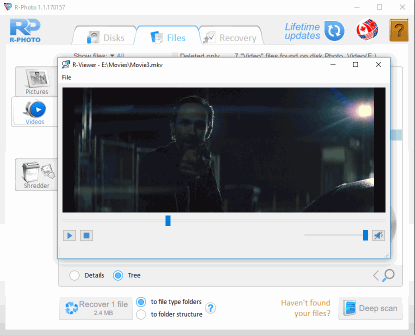
Click image to enlarge
File Viewer: Video files
R-Photo file viewer supports all photo and video file types, including raw digital photo files and modern video formats. They can be viewed even if their respective codecs are not installed in the system. You may see the complete list of supported file formats and codecs on the File Viewer help page.
When all your deleted video files are found, mark them for recovery:
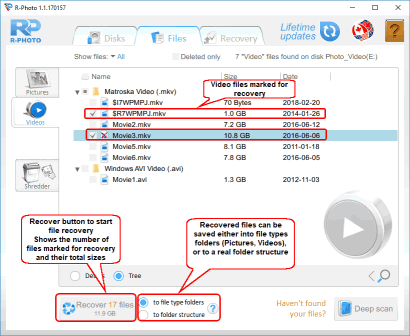
Click image to enlarge
Video files marked for recovery
When all required files are marked for recovery, there must be sufficient storage space available on another disk to save them.
Never save the recovered files on the place where they resided, or you may completely lose them!
Select the way R-Photo saves the files: either into the file type folders or to the real folder structure.
When all the necessary preparations are made, click the Recover button to start file recovery. Wait for R-Photo to recover the files and see the results.
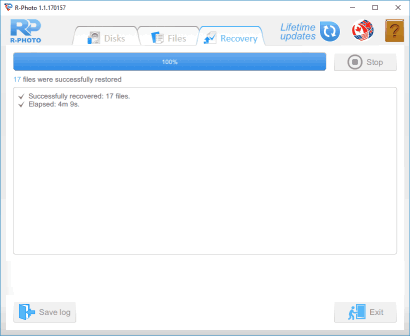
Click image to enlarge
Recovery report
When the recovery is over, the folder with recovered files will be automatically opened.
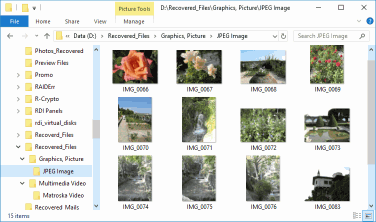
Click image to enlarge
Recovery results
Now the recovery session is over. Go to the Disks panel to start another session or click the Exit button to close the program.
Conclusions:
As you can see, photo and video file recovery using R-Photo is easy enough, even for data recovery novices. Try it for yourself to see if R-Photo to retrieve your deleted photo and video files.
- R-Studio Technician: activation using a USB stick
- Data Recovery Guide
- Why R-Studio?
- R-Studio for Forensic and Data Recovery Business
- R-STUDIO Review on TopTenReviews
- File Recovery Specifics for SSD devices
- How to recover data from NVMe devices
- Predicting Success of Common Data Recovery Cases
- Recovery of Overwritten Data
- Emergency File Recovery Using R-Studio Emergency
- RAID Recovery Presentation
- R-Studio: Data recovery from a non-functional computer
- File Recovery from a Computer that Won't Boot
- Clone Disks Before File Recovery
- HD Video Recovery from SD cards
- File Recovery from an Unbootable Mac Computer
- The best way to recover files from a Mac system disk
- Data Recovery from an Encrypted Linux Disk after a System Crash
- Data Recovery from Apple Disk Images (.DMG files)
- File Recovery after Re-installing Windows
- R-Studio: Data Recovery over Network
- How To Use R-Studio Corporate Package
- Data Recovery from a Re-Formatted NTFS Disk
- Data Recovery from an ReFS disk
- Data Recovery from a Re-Formatted exFAT/FAT Disk
- Data Recovery from an Erased HFS Disk
- Data Recovery from an Erased APFS Disk
- Data Recovery from a Re-Formatted Ext2/3/4FS Disk
- Data Recovery from an XFS Disk
- Data Recovery from a Simple NAS
- How to connect virtual RAID and LVM/LDM volumes to the operating system
- Specifics of File Recovery After a Quick Format
- Data Recovery After Partition Manager Crash
- File Recovery vs. File Repair
- Data Recovery from Virtual Machines
- How to Connect Disks to a Computer
- Emergency Data Recovery over Network
- Data Recovery over the Internet
- Creating a Custom Known File Type for R-Studio
- Finding RAID parameters
- Recovering Partitions on a Damaged Disk
- NAT and Firewall Traversal for Remote Data Recovery
- Data Recovery from an External Disk with a Damaged File System
- File Recovery Basics
- Default Parameters of Software Stripe Sets (RAID 0) in Mac OS X
- Data Recovery from Virtual Hard Disk (VHD/VHDX) Files
- Data Recovery from Various File Container Formats and Encrypted Disks
- Automatic RAID Parameter Detection
- IntelligentScan Data Recovery Technology
- Multi-pass imaging in R-Studio
- Runtime Imaging in R-Studio
- Linear Imaging vs Runtime Imaging vs Multi-Pass Imaging
- USB Stabilizer Tech for unstable USB devices
- Joint work of R-Studio and PC-3000 UDMA hardware
- Joint work of R-Studio and HDDSuperClone
- R-Studio T80+ - A Professional Data Recovery and Forensic Solution for Small Business and Individuals Just for 1 USD/day
- Backup Articles
- R-Drive Image Standalone and Corporate license transferring
- Fixing Windows update error 0x80070643 with R-Drive Image
- Backup with Confidence
- R-Drive Image as a free powerful partition manager
- Computer Recovery and System Restore
- Disk Cloning and Mass System Deployment
- Accessing Individual Files or Folders on a Backed Up Disk Image
- R-Drive Image startup / bootable version
- File Backup for Personal Computers and Laptops of Home and Self-Employed Users
- Creating a Data Consistent, Space Efficient Data Backup Plan for a Small Business Server
- How to Move the Already Installed Windows from an Old HDD to a New SSD Device and Create a Hybrid Data Storage System
- How to Move an Installed Windows to a Larger Disk
- How to Move a BitLocker-Encrypted System Disk to a New Storage Device
- How to backup and restore disks on Linux and Mac computers using R-Drive Image
- Undelete Articles
- Get Deleted Files Back
- Free Recovery from SD and Memory cards
- R-Undelete: Video Recovery
- Recovery from an External Device with a Damaged File System
- File recovery from a non-functional computer
- Free File Recovery from an Android Phone Memory Card
- Free Photo and Video File Recovery Tutorial
- Easy file recovery in three steps
Rating: 4.9 / 5
This is the easiest and the quickest data recovery software I have come across. I had to recover photos and videos out of the corrupted SD card, I tried other paid software which takes 8 hours of the deep scan to come up with less than 50% of data to recover.
R-Photo did that in a few minutes and recovered more than 35 GB of photos & videos in less than an hour, without missing a single file.
Highly Recommended.




